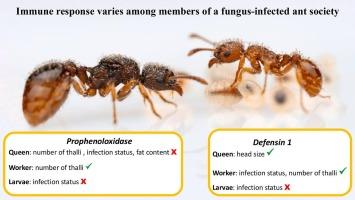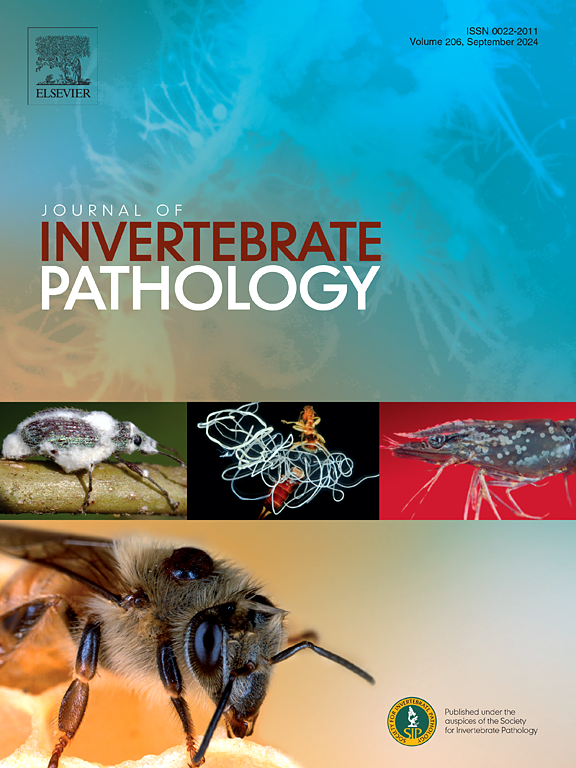在真菌感染的蚂蚁群体中,免疫反应各不相同
IF 2.4
3区 生物学
Q1 ZOOLOGY
引用次数: 0
摘要
众所周知,群居昆虫群体是各种不同寄生虫和病原体的目标,因为许多高度相关的个体密集同居。然而,在一个群体内,暴露的风险水平可能因不同群体的社会角色而异。与许多主要影响特定个体群体(如觅食者)的寄生虫不同,蜜蚁寄生真菌Rickia wasmannii感染整个蚁群,引起生理、形态和行为的微妙变化。我们通过测量防御素1和酚氧化酶原基因的表达,研究了蚁群内不同群体对真菌感染的反应,这两个基因都是蚂蚁免疫的重要组成部分。我们发现工蜂、蜂王和幼虫在防御素水平上有很大的差异,但在酚氧化酶的表达上没有差异。在相同年龄的工人中,酚氧化酶原和防御素1水平都显示出与寄生虫负荷相关的增加。在蜂王中,只有体型似乎会影响免疫基因的表达,体型较大的个体表现出更高水平的防御素1。然而,在工蜂中,形态和生理性状与基因表达无关。幼虫在免疫基因表达方面没有表现出任何明显的反应,反映出它们通常没有被真菌感染。我们的研究揭示了蚁群中不同群体之间免疫反应的相当大的差异。这些不同的反应可能源于接触寄生虫的不同,以及免疫能力的差异。本文章由计算机程序翻译,如有差异,请以英文原文为准。

Immune response varies among members of a fungus-infected ant society
Social insect colonies are known to be targeted by a wide variety of different parasites and pathogens because of the dense cohabitation of many highly related individuals. However, within a colony, the level of risk of exposure could vary among different groups depending on their social role. Unlike many parasites, which mostly affect specific groups of individuals, e.g. foragers, the myrmecoparasitic fungus Rickia wasmannii infects entire ant colonies, causing subtle changes in physiology, morphology and behaviour. We investigated how different groups within a colony respond to fungal infection by measuring the expression of the genes defensin 1 and prophenoloxidase, both vital components of ant immunity. We found that workers, queens and larvae varied considerably in defensin levels, though not in prophenoloxidase expression. In same-age workers, both prophenoloxidase and defensin 1 levels exhibited increases in correlation with parasite loads. In queens, only the body size appeared to influence immune gene expression, with larger individuals exhibiting higher levels of defensin 1. However, in workers, morphological and physiological traits did not correlate with gene expression. Larvae did not show any discernible response in immune gene expression, reflecting that they are typically not infected by the fungus. Our study reveals considerable variation in the immune response among different groups within ant colonies. These diverging reactions likely stem from differences in exposure to parasites, as well as differences in immunocompetence.
求助全文
通过发布文献求助,成功后即可免费获取论文全文。
去求助
来源期刊
CiteScore
6.10
自引率
5.90%
发文量
94
审稿时长
1 months
期刊介绍:
The Journal of Invertebrate Pathology presents original research articles and notes on the induction and pathogenesis of diseases of invertebrates, including the suppression of diseases in beneficial species, and the use of diseases in controlling undesirable species. In addition, the journal publishes the results of physiological, morphological, genetic, immunological and ecological studies as related to the etiologic agents of diseases of invertebrates.
The Journal of Invertebrate Pathology is the adopted journal of the Society for Invertebrate Pathology, and is available to SIP members at a special reduced price.

 求助内容:
求助内容: 应助结果提醒方式:
应助结果提醒方式:


